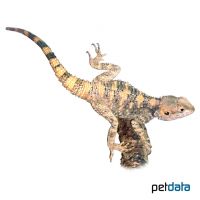Rough-tailed Rock Agama (Laudakia stellio)
| Rough-tailed Rock Agama Laudakia stellio | |
|---|---|
| Name | Rough-tailed Rock Agama |
| Name Lat. | Laudakia stellio |
| Synonym | Stellagama stellio |
| Family | Agamas |
| Family lat. | Agamidae |
| Order | Scaled Reptiles |
| Order lat. | Squamata |
| Origin | SE-Europe, Middle East |
| Habitat | Semi-desert |
| Diet | Insects, veggies, fruits |
| Humidity | 50-60 % |
| Behavior | ♂ territorial |
| Keeping | Individual, pair, harem |
| Care Level | Moderate |
| Reproduction | Oviparous |
| Housing | Dry terrarium |
| Life Span | 10 years |
| Protection | EU FFH-Directive Annex IV |
| Metric Units | |
| Size | 40 cm |
| Temperature | 25-35 °C |
| Temperature Local | 45 °C |
| Housing Size | 110 x 80 x 100 cm |
| US Units | |
| Size | 16" |
| Temperature | 77-95 °F |
| Temperature Local | 113 °F |
| Housing Size | 45" x 30" x 40" |
Distribution and habitat
Hardunes are common in Asia Minor, southwestern Asia, and southeastern Europe (Greece, Cyprus) and are the only agama species native to Europe. They require warmth, are excellent climbers and prefer rocky places with strong sunlight.
Maintenance
Minimum size for the terrarium, according to the size and number of animals:
| 1-2 animals | 5KRL x 3KRL x 4KRL (L x W x H) |
Head-torso length (KRL) is measured on the largest animal. For each additional animal, increase the footprint by 15%. A terrarium of e.g. L 110 x W 80 x H 100 cm is recommended, which should be placed in a quiet and vibration-free place
You need a desert terrarium structured with climbing branches (acacia), stones and rock structures (sandstone couch slabs under the radiation source), with hiding places and a substrate of coarse sand and boulders, a small water container and potted plants (e.g. euphorbias, aloe, oleander, agaves). A small portion of the substrate should be kept moist at all times. Once a day, preferably in the evening, the inside of the terrarium should be finely sprayed with water, but not directly the animals (risk of shock). A thermostatically controlled floor heater is recommended
| Temp. day: 25-35 °C | Temp. night: 18-20 °C | Temp. local: up to 45 °C | Humidity: 50-60 |
Lighting duration must be 10-14 hrs depending on the season. They need a high light intensity. Special lamps that produce the necessary heat and UV light are ideal. Daily UV irradiation is essential.
Diet
They feed on live insects, such as crickets, house crickets, zophobas and mealybug larvae, naked caterpillars, spiders and snails, alternatively commercial ready-made food for insectivorous reptiles can be offered, as well as sweet fruit (cherries, bananas), lettuce, dandelion flowers and wild herbs. Wax moths should only be fed in small amounts to adults, but not to juveniles, because of their large fat content. Regular addition of minerals and vitamins (dusting the feed) is important. Young animals should be offered food daily, adult animals 4-5 times a week. Drinking water must always be available
A varied diet promotes health and prevents deficiency symptoms.
Reproduction and breeding
Males have enlarged pore scales in front of the anal cleft (preanalia) and in the middle of the abdomen. They are reddish or orange in color during the mating season.
The female buries her eggs (3-5 pieces) in the substrate. The incubation period is 55-60 days at a temperature of 28 °C. Small insects are suitable as initial food for the young
The life expectancy can be 10 years.
Species protection
The animal population must be reported to the competent authority in writing immediately after the start of keeping. Your pet store will be happy to provide you with further information.
Protection of species: FFH Directive (Fauna-Flora-Habitat) of the EU Annex IV. The proof of purchase is the required proof of origin for the animal. Please keep it safe!
Important
Adult males behave very territorially and are incompatible with each other.
For the resting phase, the lighting duration is reduced by 2-3 hours and the temperature is lowered by 4-6 °C for approx. two months. For animals from Europe the temperature is reduced to 8-12 °C.
With fruit and honey water as food for the feeders, their quality can be upgraded.
The terrarium must have good ventilation without drafts and meet the species specific needs. Measuring devices such as thermometers, hygrometers, etc. are necessary. The lighting has to correspond to the species-specific day-night rhythm and has to be placed in such a way that the animals cannot injure themselves. The terrarium should be locked in such a way that neither unauthorized persons can open it nor the animals can escape. Contamination must be removed regularly
Further literature can be found in your pet store.
References
Text: petdata; Image: petdata
Source: BMELV (1997): Mindestanforderungen an die Haltung von Reptilien; .ENGELMANN (2006): Zootierhaltung - Tiere in menschlicher Obhut: Reptilien und Amphibien, Harri Deutsch Verlag
- Gemäß § 21 Abs. 5 Tierschutzgesetz idgF
